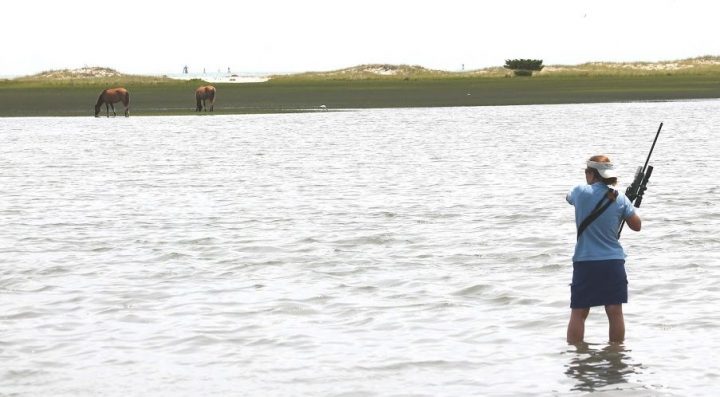
BEAUFORT – The wild horses roaming the Rachel Carson Reserve have cast a spell on residents and visitors to the downtown waterfront since the 1940s.
As a child, Beaufort native Paula Gillikin used to watch those horses from afar but now, she works to protect them.
Supporter Spotlight
“As a kid, I looked at those horses and just thought they were mystical, magical,” Gillikin said. “Never had I imagined that I would be managing them and looking after their welfare.”
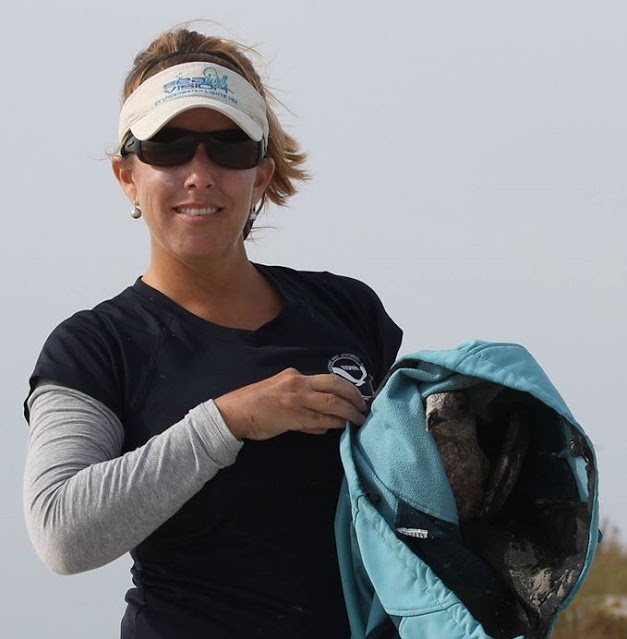
For 11 years she has been their caretaker as the central sites manager, which oversees Rachel Carson and Permuda Island reserves, two of the 10 sites making up the North Carolina Coastal Reserve and National Estuarine Research Reserve, a program of the North Carolina Division of Coastal Management, under the North Carolina Department of Environmental Quality. The North Carolina National Estuarine Research Reserve is managed through a federal-state partnership between NOAA and the Division of Coastal Management.
The reserve’s mission is “To practice and promote coastal and estuarine stewardship through innovative research and education, using a system of protected areas.”
The reserve, only accessible by ferry or boat, is comprised of a 2,315-acre network of islands: Town Marsh, Bird Shoal, Carrot Island, Horse Island and Middle Marsh, and named after ecologist and writer, Rachel Carson, who researched there in the 1940s.
Gillikin explained that the original group of Rachel Carson horses was moved from Core Banks by a resident in the late 1940s and placed on Carrot Island. A few years later, domestic horses were introduced to the herd. Given that Core and Shackleford banks and their respective groups of wild horses were once connected — Barden’s Inlet, which now separates the two, formed in 1933 — the Rachel Carson horses are related to the Shackleford horses, whose DNA exhibits Spanish ancestry.
Supporter Spotlight
The herd population, currently around 30, has had some ups and downs in the decades since but is stable now because of Gillikin and a birth-control method called immunocontraception.
Before Gillikin joined the Rachel Carson Reserve staff, there were concerns with horse management.
“When I came, we were just starting to implement this humane management program,” she said about immunocontraception, and it was exciting to be part of the process from the beginning, to “see the horses get healthier over time and to be part of achieving a healthier herd size, which means a healthier ecosystem over all.”
She said that the horses will eat themselves off the island if their population isn’t controlled.
In the grand scheme of things, Gillikin explained, immunocontraception is a relatively new technology. It’s considered humane with minimal intervention because it’s administered via dart.
“A lot people are worried that it’s hormonal and that the horses could urinate it back into the environment but it’s a vaccine.” The vaccine changes the shape of the egg, preventing pregnancy most of the time.
A Chance to Return Home
Gillikin’s skill with providing immunocontraception helped her land the central sites manager position.
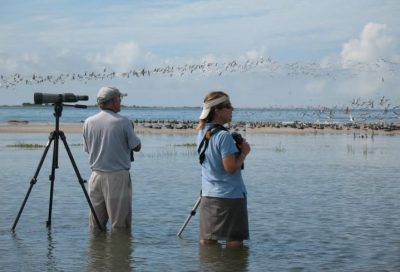
While working on a white-tailed deer immunocontraception project in South Carolina with her adviser, Dr. Allen Rutberg from Cummings School of Veterinary Medicine at Tufts University near Boston, where Gillikin earned her master’s in animals and public policy, he asked her if she would on a contract basis, go to the Rachel Carson Reserve and dart the horses.
Gillikin said that because Beaufort is her hometown and she had her own transportation, she was quick to agree.
When she was working on the reserve under contract, the pieces fell in place for her to become the full-time central sites manager, which, at the time, was a temporary position.
Gillikin said that before taking on the position at Rachel Carson, she had been applying for work all along the East Coast with no real intention of moving back home. Gillikin had been working at the Duke Marine Ecology and Conservation Lab before heading to Tufts for graduate school and after finishing up at University of North Carolina Wilmington with her bachelor’s degree.
“It was kind of by accident, and once I got into the job, I realized how perfect it was for me,” she said.
Other Responsibilities
While being caretaker of the wild horses is one of the more visible aspects of her work, she is ultimately responsible for the stewardship and management of the Rachel Carson Reserve as well as the mile-long Permuda Island near Topsail Island.
In a nutshell, she said, that means she has to make sure that the land is in its most pristine condition for the purposes that the land is protected: an outdoor laboratory and classroom for research and education.
The job also involves many different aspects of environmental planning and evaluating, making policies, natural resources survey and management, recruiting and maintaining a volunteer base to help with stewardship and making sure all of the laws that apply to the site are adhered to by both management and visitors.
She also captains the passenger vessel, supports all the education programs and is responsible for establishing and maintaining public access.
While there are different educational programs taking place on the undeveloped islands, she’s the sole caregiver of the land and wildlife that live there, including the more than 200 species of birds that have been documented at the reserve, which is designated as an Important Bird Area and critical habitat for overwintering piping plovers.
“The site has a rich diversity of shorebirds and is notable as a roosting area for waterbirds. It provides habitat that is highly valuable to migrating species such as red knot, piping plover and black-bellied plover,” she said. “Coastal birds are important sentinels of environmental change and thus a considerable amount of effort is dedicated to documenting bird use of the Rachel Carson Reserve as a part of state, regional, and international conservation efforts.”
Visitor Issues
Though the Rachel Carson Reserve demands much of her time, Permuda Island doesn’t require much.
“Permuda doesn’t have much visitation. It’s only about a mile long, is densely vegetated and has a healthy population of snakes,” she said. “Permuda is pretty low maintenance in terms of a reserve. There just isn’t a whole lot of visitation. If you have any type of visitation, there are issues that come along with it.”
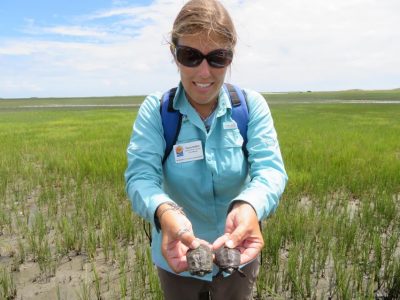
As with anything, there are some challenges, one of which includes trying to encourage all visitors to be aware of their impact on the habitat while visiting Rachel Carson Reserve.
Most visitors, she said, feel very protective of the reserve. They pick up trash, abide by the rules and enjoy the environment the way they found it or make it even better. “But some people do not share that ethic and leave trash, or try to approach wildlife closer than they should.”
Gillikin said that she works in conjunction with Cape Lookout National Seashore Park rangers a great deal on education and awareness campaigns related to wild horses.
Both she and Dr. Sue Stuska, the wildlife biologist who manages Cape Lookout’s herd, noticed they were receiving an increased number of reports of visitors inappropriately interacting with the horses, such as getting too close or trying to feed the animals, or trying to put their small child near the horse for a photo.
“We also started intercepting photos on social media of people lying down on the ground hugging foals,” she said.
Gillikin said this was worrisome because visitors could be injured and the horses could become habituated to humans. The goal is to keep the horses as wild as possible, “That’s why we all enjoy them. We enjoy their wildness and what that represents.”
Cape Lookout and Rachel Carson Reserve, along with the nonprofit Foundation for Shackleford Horses, developed a plan and have short-term and long-term goals to help educate the public.
Another issue is visitors not leashing their pets properly, giving the pets an opportunity to disturb other visitors or chase the horses.
“The horses have injured in the past people’s pets, so that’s a big challenge,” she said.
In addition to keeping the horses safe, Gillikin also has the ever-present challenge of marine debris, which is a prominent, continuous issue on the reserve.
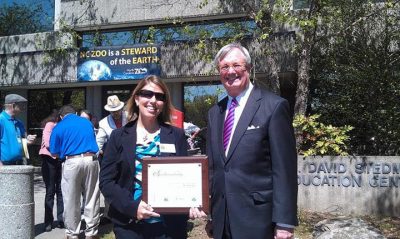
Since 2007, more than 30,000 pounds of debris have been removed from the Rachel Carson Reserve and in the past decade, they have had at least 15 boats wash ashore, she said. While most boats are claimed by the owners, several of them have become derelict and damaged the habitat.
“The most common material is plastic consumer goods – bags, bottles, take-out trays, things like that,” Gillikin said. “We see the typical consumer debris you see on any beach, but we also have lots of wood from docks, bulkheads and boats. We get lots of lumber all the time, especially after a storm.”
She said if the debris were not removed, it could cause an extensive amount of marsh damage. “And the marsh is what supports such high biodiversity. It’s the very basis of the estuarine food chain, it protects against storms and erosion, and really contributes heavily to the resilience of a nature reserve and estuarine area.”
Gillikin said they’re documenting debris removal and, with the larger objects, documenting the effects it has on the habitat and how long it takes for that habitat to recover.
“It’s a never-ending issue but it’s also an opportunity for us to do research on it,” she added. “Trying to figure out what we have out there could be a representation of what we have at any number of coastal habitats.”
Gillikin said they hope to address some of the debris and decrease certain types with a coastwide debris management plan that is under works.
Hunting is also allowed on parts of the Rachel Carson Reserve.
Gillikin said that in 1985 when the site was designated as a reserve, the land was used was for hunting, fishing, recreational activities and science because it is so close to the Duke Marine Lab on Pivers Island. The public and other stakeholders involved in creating the management guidelines had to consider the traditional uses and preserve those uses not in direct conflict with the primary purposes of protection, which are research and education.
In 2017, the reserve implemented a hunting permitting system for the first time because there had been an increase in complaints from Beaufort residents about the noise. Gillikin said that since the permits have been in place, they haven’t received any complaints.
If hunting proves to be an issue in the future, Gillikin said the reserve can take action, if needed, to lessen the affect on the habitat.
While she’s very engaged in the work she’s doing now, Gillikin said she’s encouraged to think about the future of the reserve as environmental conditions change.
“We’ve done some recent work on assessing the vulnerability of the habitats, so we are thinking about how we could potentially take actions that would keep the site as resilient and healthy as possible into the future as things change with our environment,” she said.
“It inspires me to just be a part of protecting something so beautiful and so valued by the community and making sure that it’s available for future education, research and recreation. It’s really a privilege.”







